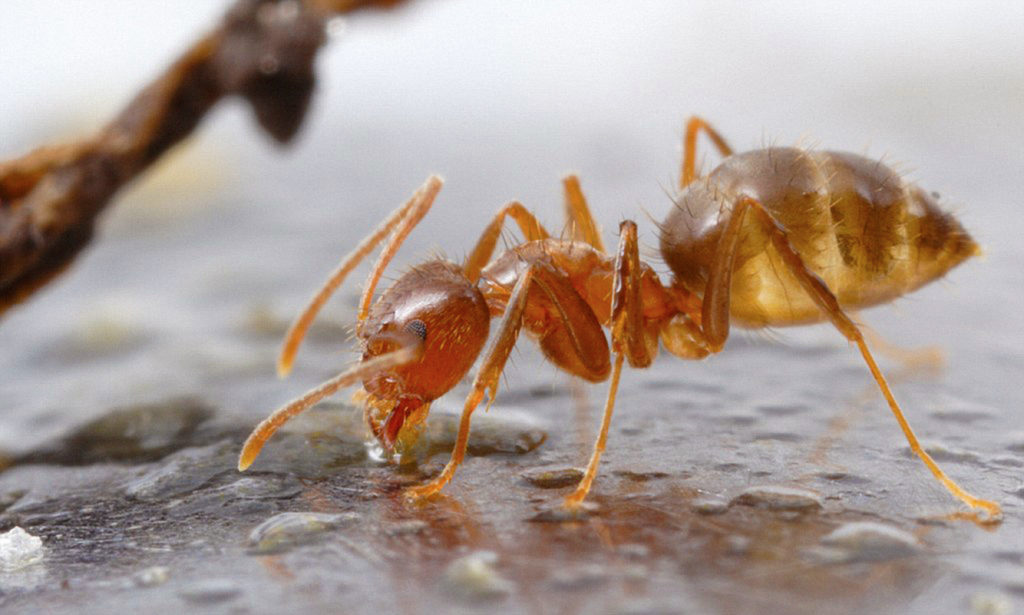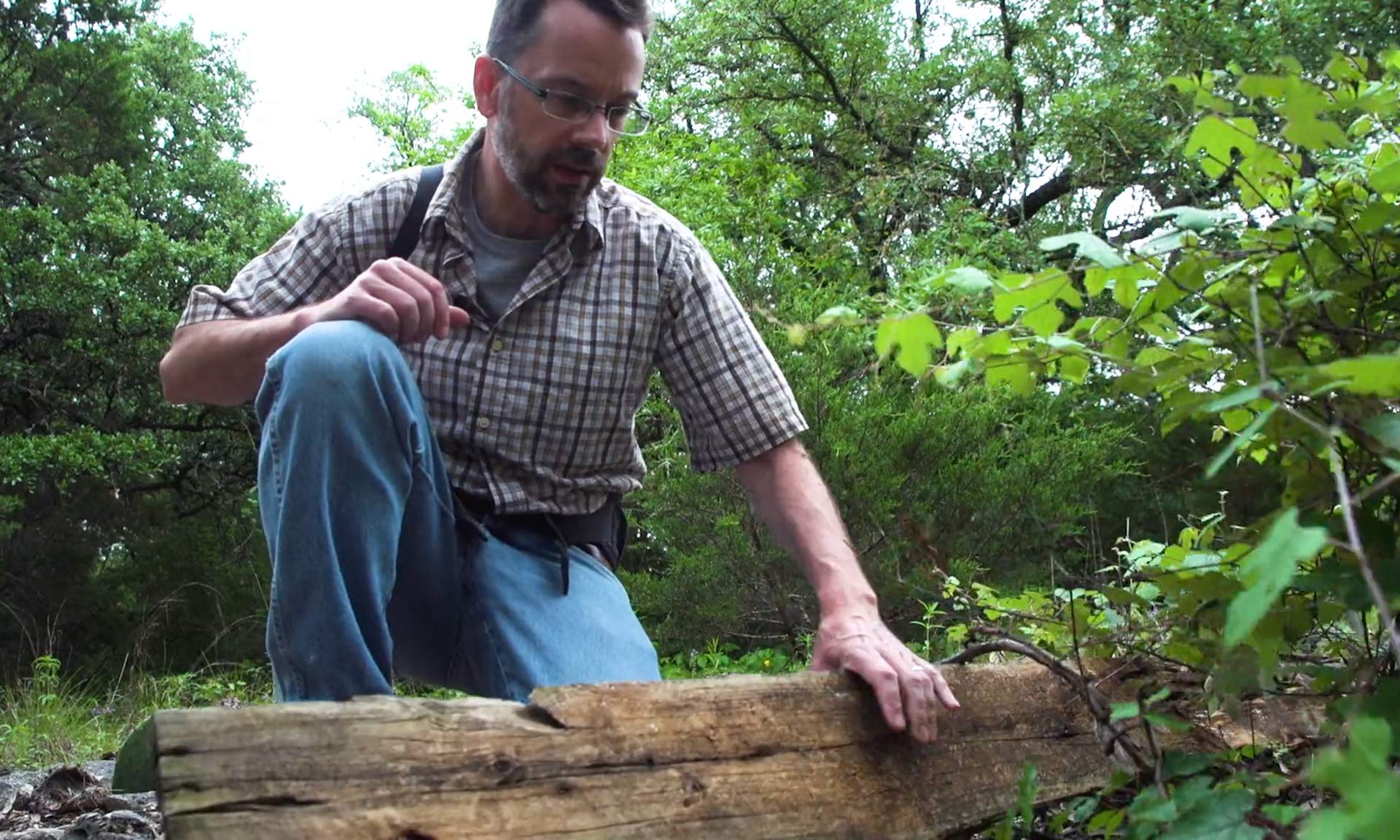An Unusual Fungus May Control Invasive Tawny Crazy Ants
08:32 minutes

The Tawny crazy ant (sometimes called the Rasberry crazy ant) is an invasive species originally found in South America. Over the past few decades, it has found a home in U.S. Gulf states and parts of Texas. The ant, named “crazy” for its erratic movements, can outcompete native ant species when it takes hold, and can overwhelm small animals with sheer numbers.
In 2013, Science Friday spoke with Edward LeBrun, a research scientist at the Brackenridge Field Laboratory of UT Austin, about the ant and its ability to outcompete fire ants in the southern U.S. Now, LeBrun returns to share news of a possible biological control for the ants, a form of fungus that can cause infected nests to collapse over a period of years. It’s a good news, bad news situation—while most insecticides and baits don’t work to control the ants, the fungus can produce local extinction.
However, it takes years to work, and currently requires transferring hundreds of infected ants into a nest—not exactly something you can pick up off the shelf at the local hardware store.

Invest in quality science journalism by making a donation to Science Friday.
Edward LeBrun is a research scientist in the Breckenridge Field Laboratory at the University of Texas at Austin in Austin, Texas.
IRA FLATOW: For the rest of the hour, an update on the tawny crazy ant. Now, if you’re not from the southern part of the US, you may not be acquainted with these ants, an introduced species that normally lives in places like Uruguay.
But over the past few decades, it’s been spreading North and often crowding out native species where it arrives in such numbers that these ants can overwhelm small animals. But researchers now report that they may have found a natural limiter on the ants. I’m talking about a fungus.
Joining me now to talk about the work published this week in the proceedings of the National Academy of Sciences is Dr. Edward LeBrun. He’s a research scientist at the Brackenridge Field Laboratory University of Texas at Austin. Welcome back to Science Friday.
EDWARD LEBRUN: Thank you, Ira. It’s good to be back.
IRA FLATOW: Describe for us what these ants do. Why are they called crazy ants?
EDWARD LEBRUN: It’s a name that’s applied to this genus and some related genera that they tend to forage in a very erratic way. So they turn a lot. So it looks like they’re crazy.
IRA FLATOW: And there’s something unusual. They are in super colonies. Explain that.
EDWARD LEBRUN: Yeah, it’s actually a trait shared by a lot of the globally significant invasive species. And what it means is that ants from different nests within a population cooperate as colony mates, and even if that population is very large, kilometers in diameter, they still all cooperate as colony mates.
And in fact, all of the infestations in the southeastern United States, to the best of our knowledge at this point, are actually extensions of the same super colony.
IRA FLATOW: Wow. Same. Are they all related, then?
EDWARD LEBRUN: Yes. Most likely, this is because they are all descended from the same colony that was originally introduced.
IRA FLATOW: Now, way back, about nine years ago, I recall we talked to you about the ants spreading north and displacing the native fire ants. Have they taken over entirely now?
EDWARD LEBRUN: No. The females can’t fly. So they don’t spread super rapidly across the landscape. People accidentally introduce them into a location and then they spread by nest fission. And so what you end up with at the landscape scale are these spots, sort of like the southeastern United States has chicken pox with dots all over it.
But those dots haven’t coalesced. So there’s still– the majority of the southeast is still not invaded by these ants.
IRA FLATOW: You mentioned nest fission, the dividing of the nest. Is that how they spread?
EDWARD LEBRUN: Yeah, locally, that’s how they spread. So that’s how they reproduce. A nest gets large, it divides into two. Some queens go with one– with workers and some queens remain and that process goes on, which leads to sort of this bacterial plaque-like form of spread. It can be up to about 100 meters a year the edge of the population as it moves.
But the way they really get around is people picking up a potted plant that has them in it and moving it, or if they have RVs, the ants move into the RVs and they go visit their favorite state park and the ants get off. So that’s the way that you get long distance dispersal with this ant.
IRA FLATOW: All right, let’s get now to the meat of this, or actually, the fungus of this, if I might say. You have found that there’s a natural fungus that seems to control them. Tell us about that.
EDWARD LEBRUN: Yeah, so it’s, actually, an organism called a microsporidia. And they reproduce inside the cells of their hosts, which are mostly insects. They produce a spore-like fungus. And the spore when it’s ingested by the host and detects the correct environmental signals, it actually fires off what’s called a polar tube, which is this harpoon like structure that’s inside the spore. Punctures the cell wall of the host, and they inject the entire contents of the spore cell into the host, take over, and start replicating.
IRA FLATOW: It sounds like I’m watching a movie.
[LAUGHS]
IRA FLATOW: Wow, that’s kind of crazy.
EDWARD LEBRUN: Yeah, they’re really remarkable. And they’re actually not well known or understood, honestly. They’re mostly pathogens of insects and also some fish and crustaceans. And they’re very diverse, but we’ve only found the tip of the iceberg of the diversity. This microsporidia, for instance, we discovered it in 2013, 2014.
And when we published it, us and collaborators at the USDA, turns out to be both a new genus and a new species.
IRA FLATOW: I’m Ira Flatow and this is Science Friday from WNYC Studios. OK, so tell us what happens to the ants when they get infected.
EDWARD LEBRUN: When they get infected, the spores actually will proliferate in fat bodies and form what’s called sporocystic sacs, which means that in a highly infected individual, you can often see a lot of fat tissue in the abdomen of the ant.
They’re shed when the ants defecate, the spores are. Eventually, they overwhelm the ant and the ant dies. And then, the spores are released into the environment when the ant decomposes.
IRA FLATOW: And why doesn’t this fungus affect the fire ants?
EDWARD LEBRUN: Well, like a lot of pathogens, it’s a very species specific. And there’s a lot we don’t know about this fungus. We don’t actually know where it’s from. We don’t know if its host was originally tawny crazy ants. But what we do know is that we’ve tested a bunch of ants– native ants in areas where they’re interacting with infected tawny crazy ants or in areas where there has been a tawny crazy ant population that has collapsed because of this disease. And none of these ants in nature have the disease.
So it seems to be, at least within this context of North America, very specific to tawny crazy ants.
IRA FLATOW: So how long does it take to get rid of the whole colony? For the colony to collapse once it’s infected?
EDWARD LEBRUN: Yeah, so we began back in 2009 looking at these ants and tracking their densities. And then, once we discovered this pathogen, we were able to go back in time and look at their infection levels and then continue that process in other populations. And what we found is that infected populations would decline, and decline to the point of local extinction– which is a very rare thing in host pathogen interactions– over a period of four to seven years.
IRA FLATOW: Wow, that’s pretty fast, isn’t it?
EDWARD LEBRUN: Yeah, it certainly is fast for a population to– these incredibly dense populations to just entirely disappear. I think if you’re a homeowner, you wouldn’t find it very fast.
IRA FLATOW: Well, that’s my next question. If I’m a homeowner, can I go to one of the big box stores and buy the fungus and throw it on my lawn?
EDWARD LEBRUN: No. At this point, the only way that we can successfully introduce the fungus into an uninfected population is to take advantage of that trait– that super coloniality that I was talking about. And the fact that ants aren’t aggressive to ants from distant locations. And collect infected ants and bring them and then introduce them into uninfected nests.
And the uninfected ants, actually, have a lot of behaviors they use to avoid acquiring the infection. So even that process is not 100%. You have to do quite a few introductions and get lucky to some degree. Generally, it’s feasible to do it, but it’s quite labor intensive.
IRA FLATOW: And where do you imagine this being used mostly, if we’re not putting it in our homes?
EDWARD LEBRUN: Where we are doing it now, and where it seems like it’s most appropriate, are areas of high conservation value. State parks, for instance, areas where people go to enjoy nature. But also areas that have endangered species or rare species. We’re doing in environments where– karst environments– cave environments where there is endangered cave invertebrates, in areas where endangered birds are nesting.
IRA FLATOW: Interesting. I’m just fascinated by the specificity of the fungus attacking this kind of ant and not the other kinds of ants. It’s just fascinating.
EDWARD LEBRUN: Yeah, it is fascinating. And it’s the basis for biological control generally. I mean, we use biological control for that reason. Because pathogens tend to be very specific and parasites and parasitoids tend to be very specific to their hosts. So if you can get one that’s specific and tested and prove that it’s specific, then you– there’s a good chance that you’re not going to do unintended harm.
In this case, the disease was already present in North America. So the potential for unintended harm is pretty low.
IRA FLATOW: Crazy stuff. Very fascinating stuff, Edward. Thank you for taking time to be with us today.
EDWARD LEBRUN: Not at all, Ira. I really appreciate the invitation.
IRA FLATOW: You’re Welcome. Edward LeBron, research scientist at the Brackenridge Field Laboratory University of Texas at Austin.
Copyright © 2022 Science Friday Initiative. All rights reserved. Science Friday transcripts are produced on a tight deadline by 3Play Media. Fidelity to the original aired/published audio or video file might vary, and text might be updated or amended in the future. For the authoritative record of Science Friday’s programming, please visit the original aired/published recording. For terms of use and more information, visit our policies pages at http://www.sciencefriday.com/about/policies/
As Science Friday’s director and senior producer, Charles Bergquist channels the chaos of a live production studio into something sounding like a radio program. Favorite topics include planetary sciences, chemistry, materials, and shiny things with blinking lights.
Ira Flatow is the founder and host of Science Friday. His green thumb has revived many an office plant at death’s door.